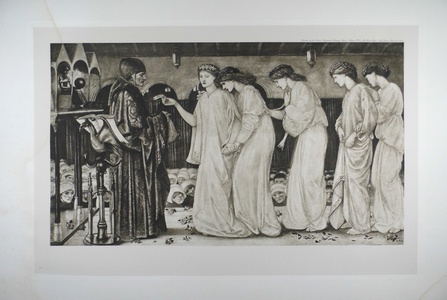| Method | Photogravure |
| Artist | after Sir Edward Coley Burne-Jones |
| Published | Published by the Berlin Photographic Company Berlin. _ London W.133 New Bond Street. _ New York 14 East 23rd Street. [c.1900] |
| Dimensions | Image 273 x 477 mm, Plate 348 x 535 mm, Sheet 507 x 667 mm |
| Notes |
Printed on India laid paper. Plate 41, taken from Burne-Jones' 1865-6 oil painting of the same title, from 'The Work of Edward Burne-Jones, Ninety-One Photogravures Directly Reproduced from the Original Paintings'. Only two-hundred copies of the 'The Work of Edward Burne-Jones...' were produced, each of which was signed by Philip Burne-Jones, the eldest son of Edward. Burne-Jones' 'Princess Sabra Drawing the Lot' is the third in a series of seven paintings by the artist titled 'Saint George and the Dragon', which portrayed the legend of the same title. Circulated since the Middle Ages, the tale states that Princess Sabra was to be the next victim sacrificed to the dragon. Georges de Lydda, a Christian nobleman and Roman army officer, saves the princess from the beast. In return for slaying the dragon, Sabra's father, the King, and his followers, convert to Christianity. The legend, imbued with chivalrous ideal, proved to be extremely popular in the circle of the Pre-Raphaelites. 'Princess Sabra Drawing the Lot' captures the moment that the Princess is allotted as the next sacrifice to the dragon. Having just drawn the fatal lot from the soothsayer's bag, Sabra holds in her right hand a piece of paper inscribed with 'MORITURA'. Four sorrowing maidens stand to the right of the Princess, whilst the heads of the assembly surround the platform. To the left of the composition, a small statue of Fortune sits upon a raised dais. The painting from which this photogravure was taken is now in the collection of Hanover College, Indiana. Sir Edward Coley Burne-Jones, 1st Bt (1833-1898) was a painter and designer closely associated with the later phase of the Pre-Raphaelite movement. Burne-Jones met William Morris as an undergraduate of Exeter College, Oxford, whilst studying for a degree in theology. The pair went on to work very closely together on numerous decorative arts projects including stained glass windows, tapestries, and illustrations. Originally intending to become a church minister, Burne-Jones never finished his degree, choosing instead to pursue an artistic career under the influence of Dante Gabriel Rossetti. Rossetti heavily inspired his early work, but by the 1860's his idiosyncratic style was beginning to develop. His mature work, however different in total effect, is rich in conscious echoes of Botticelli, Mantegna and other Italian masters of the Quattrocento. Thusly, Burne Jones' later paintings of classical and medieval subjects are some of the most iconic of the Pre-Raphaelite movement. He was at the height of his popularity during the 1880's, though his reputation began to decline with the onset of the Impressionists. He was created a baronet in 1894, when he formally hyphenated his name. The Berlin Photographic Company, (1880 - 1920; fl) or the Berlin Photographische Gesellschaft, was a German print publishers who specialised in photogravures after Old Masters and contemporary painters. High quality photographs were taken of the original works. The negatives were then exposed onto a gelatin covered copper plate, etched with acid, and printed in a similar fashion to an engraving. The main series of the Berlin Photographic Company's publications is kept together at Blythe House, West Kensington. Condition: Foxing and discolouration to edges of sheet, water stains to upper left and lower right corners, slightly affecting upper left of image. |
| Framing | unmounted |
| Price | £400.00 |
| Stock ID | 41563 |

